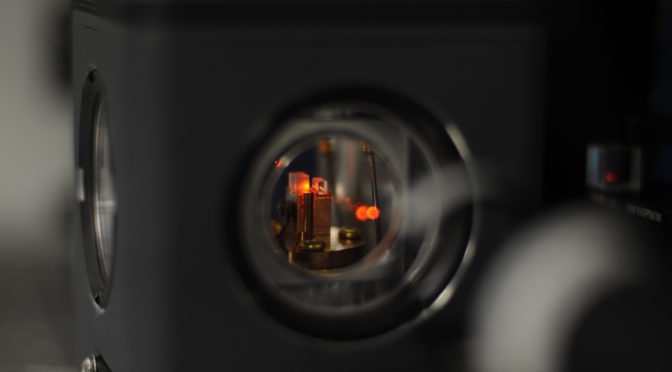The coherent mapping of quantum information between light and matter is a crucial requirement in quantum information science. Here, we study the interaction between single photons and cryogenically cooled crystals doped with rare-earth ions. Rare-earth doped crystals are promising for quantum storage applications because they provide a unique system where a large number of atoms with excellent spin and optical coherence properties are naturally trapped in a solid state matrix. Our solid state quantum memories are based on a crystal doped with praseodymium ions, namely Pr3+:YSi5O2. There are many storage protocols based on the rephrasing of optical coherences. We are mainly focused on the so-called atomic frequency comb technique [1]. The principal objective of our project is to store quantum states of light in long lived collective spin excitations, which would be the main ingredient for many quantum information protocols, e.g. quantum repeaters.
We are working on two parallel projects which are fundamentally different: an emissive quantum memory, where the stored photons are generated inside the memory, and an absorptive quantum memory, for the storage of externally generated single photons. Moreover we are studying integrated quantum memories based on laser-written waveguides, a work done in collaboration with the group lead by Prof. Roberto Osellame in Politecnico di Milano.
[1]: M. Afzelius, C. Simon, H. de Riedmatten, and N. Gisin, “Multimode quantum memory based on atomic frequency combs,” Phys. Rev. A 79, 52329 (2009).
Storage of heralded single photons in a bulk crystal
Using the atomic frequency comb technique (AFC) we demonstrated the first quantum memory in solid state [2], storing weak coherent states with less than one photon per pulse into a collective spin excitation and retrieving them on demand. Parallely an ultranarrowband source of spectrally-multiplexed photon pairs was developed (see Quantum light sources) [3], with one photon of the pair matching the wavelength and the linewidth of the AFC (~4MHz at 606nm) and the other at telecom wavelength. Using the second photon as herald, we demonstrated the first storage with on-demand read-out of heralded single photons generated by an external source in a solid-state quantum memory [4]. This experiment is the first step towards the realization of a quantum repeater link, main objective of this project.
[2] Mustafa Gündoğan, Patrick M. Ledingham, Kutlu Kutluer, Margherita Mazzera, and Hugues de Riedmatten “Solid State Spin-Wave Quantum Memory for Time-Bin Qubits”, Phys. Rev. Lett. 114, 230501 (2015).
[3] J. Fekete et al. “Ultranarrow-band photon-pair source compatible with solid state quantum memories and telecommunication networks.” Physical review letters 110.22, 220502 (2013).
[4] A. Seri et al. “Quantum correlations between single telecom photons and a multimode on-demand solid-state quantum memory.” Physical Review X 7.2, 021028 (2017).
Integrated quantum memories
One of the main advantages of working with solid state memories is the possibility to have integrated and miniaturized devices. This would give higher scalability, mechanical stability and, having light highly confined along the whole length of the crystal, would increase the light-matter interaction.
To this aim, we are studying laser-written waveguides fabricated via femtosecond laser micromachining by our collaborators Dr. Giacomo Corrielli and Prof. Roberto Osellame in Politecnico di Milano: a highly focused fs-pulsed laser irradiated into a bulk crystal can lead to a localized change of the refractive index of the material. This technique can be used to fabricate different kind of waveguides. In a fabrication regime, the bulk sample is irradiated at high energy fluence for producing a pair of damaged material tracks that form the waveguide cladding, and light is guided between them due to a stress-induced positive refractive index change. This kind of structure is called type II waveguide. In this kind of waveguide, after showing that the spectral and coherence properties were maintained with respect to the bulk and that the light-matter interaction was increased as expected for the confinement of the light into the waveguide, we demonstrated the first storage with on-demand readout in an integrated optical memory [5].
The second waveguide that we analysed, substantially different from the previous one, is the so-called type I waveguide. In this case the waveguide core is directly irradiated, with a much lower energy fluence, for a positive refractive index change at the irradiated material volume. This gives much smaller waveguides, meaning a further increase of the light-matter interaction (~10 times higher than in bulk crystal) and the possibility to have all-integrated devices, like fiber-pigtailed waveguides or complex optical circuits coupled to waveguide arrays. We demonstrated [6] that the fabrication of the waveguide does not change the spectral properties of the ions and that the coherence remains of the same order of magnitude as in the bulk. Moreover we performed storage of heralded single photons in the excited state using the atomic frequency comb technique, demonstrating a new integrated system for quantum storage.
This new device opens the way to a lot of new possibilities, both related to the higher light matter interaction and, most of all, to the possibility to couple our waveguides to fibers and optical circuits. Moreover, to our knowledge, this fabrication technique is the only one with direct 3-dimensional capabilities, which would allow high spatial multiplexing by an efficient exploitation of the substrate volume, with matrices of quantum memories interconnected to linear fiber arrays by glass circuits.
[5] Giacomo Corrielli, Alessandro Seri, Margherita Mazzera, Roberto Osellame, and Hugues de Riedmatten, “Integrated Optical Memory Based on Laser-Written Waveguides”, Phys. Rev. Applied 5, 054013 (2016) .
[6] Alessandro Seri, Giacomo Corrielli, Darío Lago-Rivera, Andreas Lenhard, Hugues de Riedmatten, Roberto Osellame, Margherita Mazzera, “A novel integrated platform for quantum storage of heralded single photons”, arXiv:1805.02494v1 (2018).
People in this Project:
Funding:

